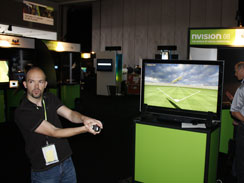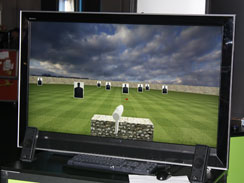
During our wander around the show floor at Nvision, we bumped into Sixense, a company that’s been under the radar for around 18 months developing a new 3D input device that shows some incredible promise.
The device is best looked upon as a more advanced Wiimote, as it uses realistic movements to control how you interact with the game – that’s where the similarities stop though, because the Sixense is based on precise tracking relative to a base station and has the ability to react to movement in six degrees of freedom.
When I asked Sixense CEO Amir Rubin how precise, he said that it was accurate to the nearest millimetre or degree, and updates every ten milliseconds. Rubin added that it could be even more precise if required, but based on what we’ve seen it isn’t needed... for the time being at least.
Sixense had the device hooked up to a notebook, which in turn was connected to a big screen TV and ran a series of relatively simple demos. When we asked why the demos were so simple, the company’s representatives said they were merely designed to capture the imagination of developers and enable them to use their own imagination to create ways to use the technology.
Of the demos shown, there was a paintball game, a lightsabre simulator (by far the coolest of them all!) along with simple squash, golf, American football and baseball minigames. Despite being incredibly simple, they all showed off the Sixense’s potential really well.
Rather than go through how each and every demo used the technology, it’s probably easiest to describe the paintball game. You moved around with the device just like you’d duck, weave and dive to dodge bullets – you twist your wrist, the gun twists with them; you hold the controller vertically, the gun points upwards and so on. By far the most impressive part of this particular demo was when you ducked down, as your character in the game ducks down behind the wall in front of the shooting point.
I was blown away at this point, but there was more to come because Sixense had thought up more usage models that are outside of what I’d refer to as the natural space for a device like this (i.e. casual gaming) – the company’s reps introduced us to another demo that had never before been seen.
We were dropped into a giant sandbox world full of random objects. Inside this world, I was able to use a pair of controllers to grab, move, rotate and even manipulate the objects. Thankfully, I was able to get a couple of videos of this technology running – that’s probably the best way to show it working.
Rubin said that Sixense was talking to all of the major publishers and claimed that there has been a lot of excitement surrounding the product following around six months of hands-on testing with it. I can understand why, too, because after playing around with the device myself I was impressed. It didn’t have quite the same smack-in-the-face wow factor as Jeff Han’s multi-touch demo, but Sixense is at least an equal to Han’s efforts.
I can’t wait to see how this will be implemented into games, and I hope the technology comes sooner rather than later. Share your thoughts with us in the forums.
The device is best looked upon as a more advanced Wiimote, as it uses realistic movements to control how you interact with the game – that’s where the similarities stop though, because the Sixense is based on precise tracking relative to a base station and has the ability to react to movement in six degrees of freedom.
When I asked Sixense CEO Amir Rubin how precise, he said that it was accurate to the nearest millimetre or degree, and updates every ten milliseconds. Rubin added that it could be even more precise if required, but based on what we’ve seen it isn’t needed... for the time being at least.
Sixense had the device hooked up to a notebook, which in turn was connected to a big screen TV and ran a series of relatively simple demos. When we asked why the demos were so simple, the company’s representatives said they were merely designed to capture the imagination of developers and enable them to use their own imagination to create ways to use the technology.
Of the demos shown, there was a paintball game, a lightsabre simulator (by far the coolest of them all!) along with simple squash, golf, American football and baseball minigames. Despite being incredibly simple, they all showed off the Sixense’s potential really well.
Rather than go through how each and every demo used the technology, it’s probably easiest to describe the paintball game. You moved around with the device just like you’d duck, weave and dive to dodge bullets – you twist your wrist, the gun twists with them; you hold the controller vertically, the gun points upwards and so on. By far the most impressive part of this particular demo was when you ducked down, as your character in the game ducks down behind the wall in front of the shooting point.
I was blown away at this point, but there was more to come because Sixense had thought up more usage models that are outside of what I’d refer to as the natural space for a device like this (i.e. casual gaming) – the company’s reps introduced us to another demo that had never before been seen.
We were dropped into a giant sandbox world full of random objects. Inside this world, I was able to use a pair of controllers to grab, move, rotate and even manipulate the objects. Thankfully, I was able to get a couple of videos of this technology running – that’s probably the best way to show it working.
Rubin said that Sixense was talking to all of the major publishers and claimed that there has been a lot of excitement surrounding the product following around six months of hands-on testing with it. I can understand why, too, because after playing around with the device myself I was impressed. It didn’t have quite the same smack-in-the-face wow factor as Jeff Han’s multi-touch demo, but Sixense is at least an equal to Han’s efforts.
I can’t wait to see how this will be implemented into games, and I hope the technology comes sooner rather than later. Share your thoughts with us in the forums.

MSI MPG Velox 100R Chassis Review
October 14 2021 | 15:04









Want to comment? Please log in.